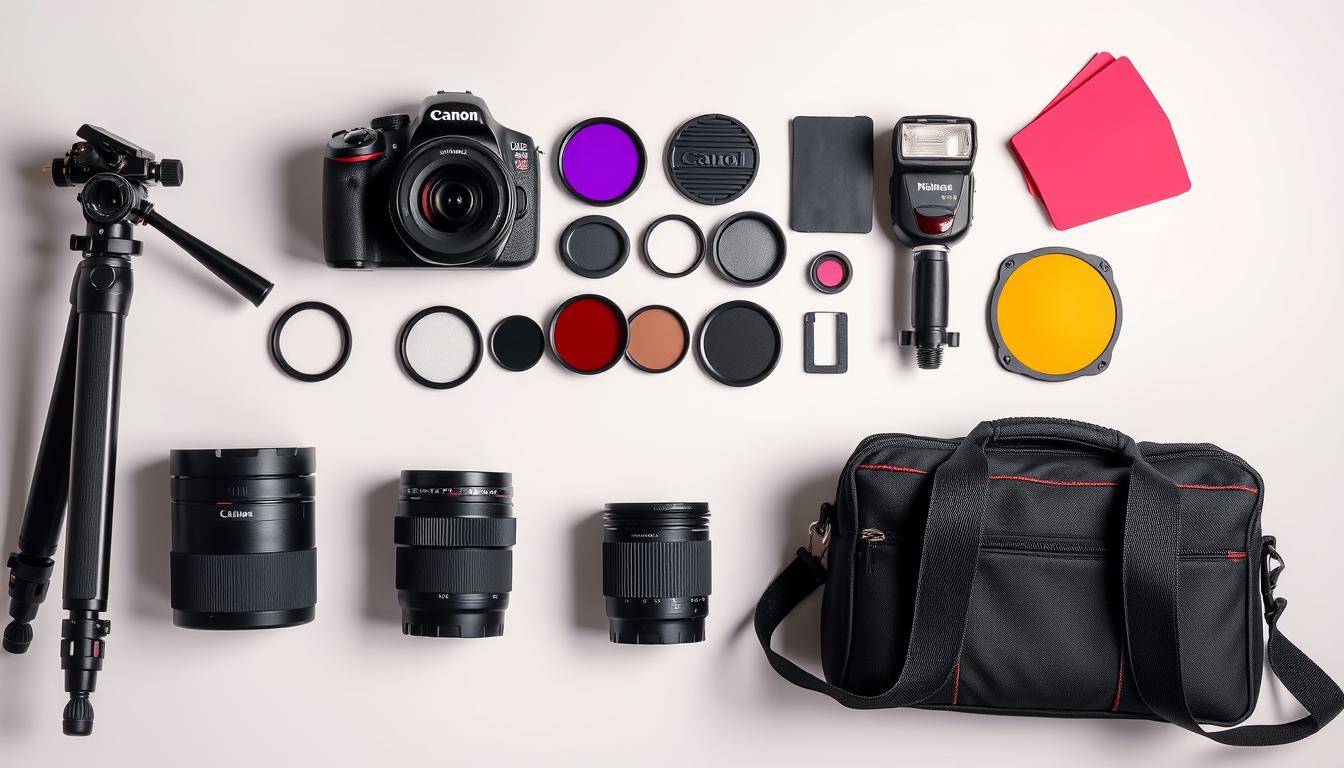Starting a photography business can be a dream come true. It needs careful planning and a solid business plan. You must define your niche and create a strong strategy. With the right steps, you can make your passion a thriving career.
A good photography business plan is key to starting your business. It helps you understand legal needs and your business vision. By following a detailed plan, you can start your photography business on the right path.
Essential Steps to Start a Business in Photography
Starting your photography business needs a strong foundation. You must define your niche, create a business plan, and know the legal rules. This will help you market your photography well and follow the law.
Choosing your photography niche is the first step. You can focus on weddings, landscapes, or portraits. Knowing your niche helps you find the right clients and offer what they need. A good business plan sets goals, understands the market, and plans your money.
Defining Your Photography Niche
Some common photography niches include:
- Commercial Photography
- Real Estate Photography
- Product Photography
Creating a Business Plan
A detailed business plan should have:
- Executive summary
- Market analysis
- Financial projections
Understanding Legal Requirements
Knowing the legal needs for your photography business is key. This includes getting the right licenses and permits. By using good marketing and following the law, you can build a successful photography business.
| Legal Requirement | Description |
|---|---|
| Licenses | Get the licenses needed to run a business in your state |
| Permits | Get permits to run a business in your city or county |
Building Your Professional Photography Kit
Starting your photography business means investing in top-notch equipment. Your kit should have cameras, lenses, and lighting. Think about your budget and what your photography niche needs.
Some key items to consider when building your kit include:
- Cameras: Choose a camera that meets your needs, such as a DSLR or mirrorless camera.
- Lenses: Invest in a variety of lenses, including wide-angle, telephoto, and macro lenses.
- Lighting: Consider investing in external lighting sources, such as flash units or continuous lights.
When picking your gear, look into different brands and models. Brands like Canon, Nikon, and Sony are popular. By doing your research and choosing the right equipment, you’re on your way to a successful photography business.
| Equipment | Description |
|---|---|
| Camera | The main component of your photography kit |
| Lenses | Essential for capturing high-quality images |
| Lighting | External lighting sources to enhance your photos |
Setting Up Your Business Structure and Finances
Starting your photography business means setting up a strong structure and financial system. This helps you manage money well, meet tax needs, and make smart business choices. A good photography business plan is key to these goals.
Choosing a business type is important. You can pick from sole proprietorship, LLC, or corporation. Each has its own benefits and drawbacks. For example, an LLC can protect your assets and offer tax perks, which are good for your business and client relationships.
Here are some key things to think about for your business finances:
- Open a separate business bank account to keep your personal and business finances separate
- Understand your tax obligations and ensure you’re meeting your tax deadlines
- Establish a pricing structure that reflects the value of your work and helps you manage client expectations
A clear pricing structure is key for managing client relationships. It sets expectations and ensures you get paid fairly. With a solid business plan, you can build strong client relationships and deliver great services.
By following these steps, you’ll set up a successful photography business with a strong financial base. Always review and update your business plan to keep it effective in managing client relationships.
| Business Entity | Pros | Cons |
|---|---|---|
| Sole Proprietorship | Easy to set up, low costs | No personal asset protection, unlimited personal liability |
| LLC | Personal asset protection, tax benefits | More complex to set up, higher costs |
| Corporation | Limited personal liability, tax benefits | Most complex to set up, highest costs |
Creating Your Brand Identity
When you start your photography business, building a strong brand is key. Photography branding is more than just a logo. It’s about showing a consistent image and message that shows what your business is all about. Your brand identity makes you stand out and helps people know what you offer.
To build a strong brand, you need a professional website and to be active on social media. Use the same logos and colors everywhere. This builds trust and makes people recognize your brand. Here are some things to think about for your photography branding plan:
- A unique and memorable logo
- A professional website that showcases your work
- Consistent social media presence across all platforms
- A clear and concise message that communicates your brand’s value
By focusing on photography branding, you can lay a solid foundation for your business. This attracts clients who love your unique style and approach. Always keep your brand consistent across all platforms to create a strong and recognizable brand.

Developing Your Photography Portfolio
Your portfolio is key as a photographer. It shows your skills and style. It’s important to make a portfolio that highlights your best work and shows your expertise to clients.
Think about the type of photography you do and who you want to reach. Your portfolio is a big part of your marketing. It helps build your brand and attract new clients.
To make a great portfolio, pick your best photos and organize them well. You can group them by type, like landscape or portrait. This makes your portfolio tell a story or show your range.
After picking and organizing your photos, create an online space for your portfolio. You can make a website or use social media. A strong online presence helps you reach more people and grow your business.
Remember to update your portfolio often. This keeps your audience interested in your work and services.
Selecting Your Best Work
- Choose photos that show your technical skills and creativity
- Think about the type of photography you specialize in and who you’re trying to reach
- Make sure your photos are high-quality and well-edited
Organizing by Category
Organizing your photos by category makes your portfolio easy to use. You can have sections for different types of photography, like landscape or portrait.
Marketing Strategies for Photographers
Starting a photography business means you need good marketing strategies. These help attract clients and grow your brand. Think about how you’ll reach your audience when starting out.
Social media, like Instagram and Facebook, is great for sharing your work. It helps you connect with people and build your brand. Also, having a good website makes it easier for clients to find you. Networking can bring collaborations, referrals, and advice from others in the field.
Some important marketing strategies for photographers include:
- Creating a strong online presence through social media and your website
- Developing a unique and consistent brand identity
- Engaging with your audience through regular updates and behind-the-scenes content
- Collaborating with other photographers and industry professionals
- Utilizing search engine optimization (SEO) techniques to improve your website’s visibility
Using these strategies can help promote your business and attract new clients. Always keep your target audience in mind and adjust your marketing as your business changes.
| Marketing Strategy | Benefits |
|---|---|
| Social Media Marketing | Increased brand awareness, engagement with clients |
| Website Optimization | Improved visibility online, easier for clients to find you |
| Networking with Other Professionals | Collaborations, referrals, valuable advice |
Managing Client Relationships
As a photographer, you know how vital client relationships in photography are. Building trust and delivering top-notch work are essential for happy clients and referrals. A solid photography business plan must have strategies for handling client relationships well.
To do this, focus on a few important points:
- Clear communication: Start by setting clear expectations, like pricing, timelines, and what the client will get from the shoot and final products.
- Open dialogue: Keep talking throughout the project to make sure the client’s needs are met and any issues are fixed quickly.
- High-quality service: Always aim to provide outstanding service and products that go beyond what the client expects.
By adding these to your photography business plan, you can build strong client relationships in photography. A happy client is more likely to come back and tell others about your work.
Managing client relationships well is key to your photography business’s success. Focus on clear communication, open dialogue, and top-quality service. This will help you build lasting client relationships in photography and grow your business.
Scaling Your Photography Business
As your photography business grows, it’s key to scale your operations. This means managing your workload better, expanding services, and making things more efficient. Scaling your business needs careful planning and the right steps, but it can take you to new heights.
To grow your business, consider hiring assistants or staff for tasks like editing and customer service. This lets you focus on marketing, client relationships, and growing your business. You can also offer more services, like videography or workshops, to your clients.
Hiring the Right Team
Finding the right team is vital for scaling your business. Look for people who share your vision and are skilled in photography, marketing, and customer service. Use online platforms, job boards, or social media to find candidates.
Implementing Automation and Systems
Automation and systems can streamline your operations and save time. Tools like invoicing software and scheduling apps can automate tasks. This lets you focus on creativity and serving your clients better.
Scaling your business can boost your income, grow your client base, and make you a top photographer. Stay focused on your goals and keep improving your marketing strategies for lasting success.
Conclusion
Starting a photography business is a long-term goal, not a quick fix. Stay focused, keep going, and love what you do. Follow the steps in this guide to make your photography dream a reality. Define your niche, plan your business, build your kit, create your brand, and market your services.
The photography world is tough, but you can stand out. Improve your skills, grow your portfolio, and connect with clients. Learn from your mistakes and adapt to changes in the industry.
Don’t wait to start. Reach out to clients, network, and dive into the photography world. With hard work and a desire to learn, you’ll overcome any hurdle. So, let’s get started on your photography business journey. It’s time to make your photography business plan come to life.
FAQ
What are the essential steps to start a business in photography?
First, define your photography niche. Then, create a business plan. Next, understand legal requirements.
Build your professional photography kit. Set up your business structure and finances. Lastly, create your brand identity.
How do I build a professional photography kit?
Start by investing in quality cameras and lenses. Also, get the right lighting and accessories for your niche.
Remember to consider your budget. Think about what your photography type needs.
What are the key considerations for setting up my business structure and finances?
Choose the right business entity, like a sole proprietorship or LLC. Set up a dedicated business bank account.
Understand your tax obligations. Also, set prices that show the value of your work.
How do I create a strong brand identity for my photography business?
Develop a consistent visual style. This includes a professional logo, website, and social media presence.
Your brand should reflect your photography style. It helps clients understand what you offer.
What are effective marketing strategies for photographers?
Use social media platforms to your advantage. Make sure your website is easy to find online.
Network with other photographers. This helps you reach more clients.
How can I scale my photography business?
Hire assistants or staff to help with the workload. Expand your services to reach more clients.
Use automation to make your operations smoother. This lets you focus on creativity and strategy.





